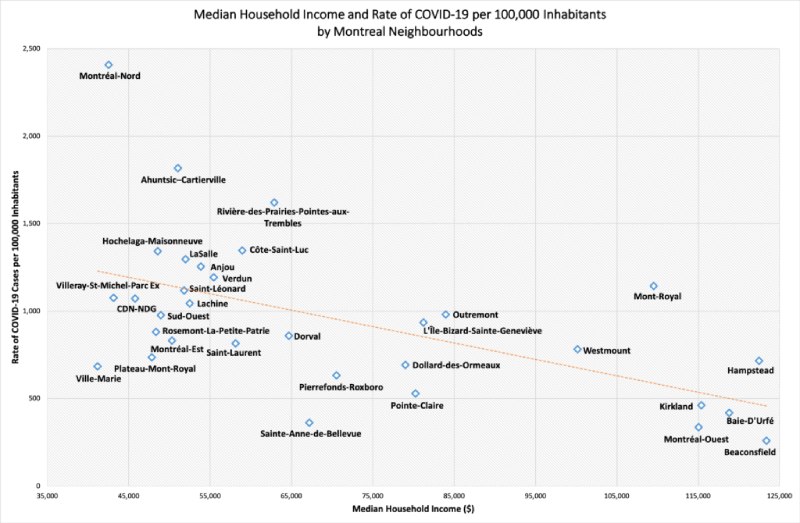
Research team members collected data and created scatterplots comparing household income and COVID-19 case rates for a large number of cities in Canada and the United States, including Toronto, Chicago, Detroit, Phoenix, Houston, Philadelphia, Miami, San Antonio and San Jose.
A consistent pattern of higher rates of COVID-19 cases was found in low-income neighborhoods in most of the cities that were studied.
In Canada, Toronto has been added at the neighborhood level. As with other cities, the general pattern is a negative relationship between the rate of COVID-19 cases per 100,000 residents and median household income. Neighborhoods with the highest rates of COVID-19 cases include Humber Heights-Westmount with 1,622 cases per 100,000 residents and Weston with 1,354 cases per 100,000 residents. The neighborhood with the lowest rate of COVID-19 cases was The Beaches with 60 cases per 100,000 residents.
Detroit stands out as the only city with a trend line showing a positive relationship between median income and the rate of COVID-19 cases per 100,000 residents. Detroit has a smaller area (138 square miles) than most of explored cities. It is possible that Detroit's small metropolitan area results in less income disparity between zip codes.
Detroit's lack of high-income zip codes may also be due to its unique pattern. In other cities, the rate of COVID-19 cases begins to decline after the median income reaches $100,000. Detroit's highest median income by zip code is $41,297, and Detroit overall is one of the economically poorest cities in the United States.
Detroit's median income is $29,481 compared to $61,937 for the entire US territory (US Census Bureau, 2018). The social gradient in health may be less visible in Detroit because the city as a whole has lower incomes, so there is generally less income inequality between neighborhoods.
These scatterplots are the first step in an ongoing project examining the spatial variation and social determinants of the impact of COVID-19 in North American cities. Many factors can affect the levels of COVID-19.
For example, Humber Heights-Westmount, one of Toronto's neighborhoods with the highest rate of COVID-19 cases, has a median income but a higher-than-average proportion of its population is elderly.



